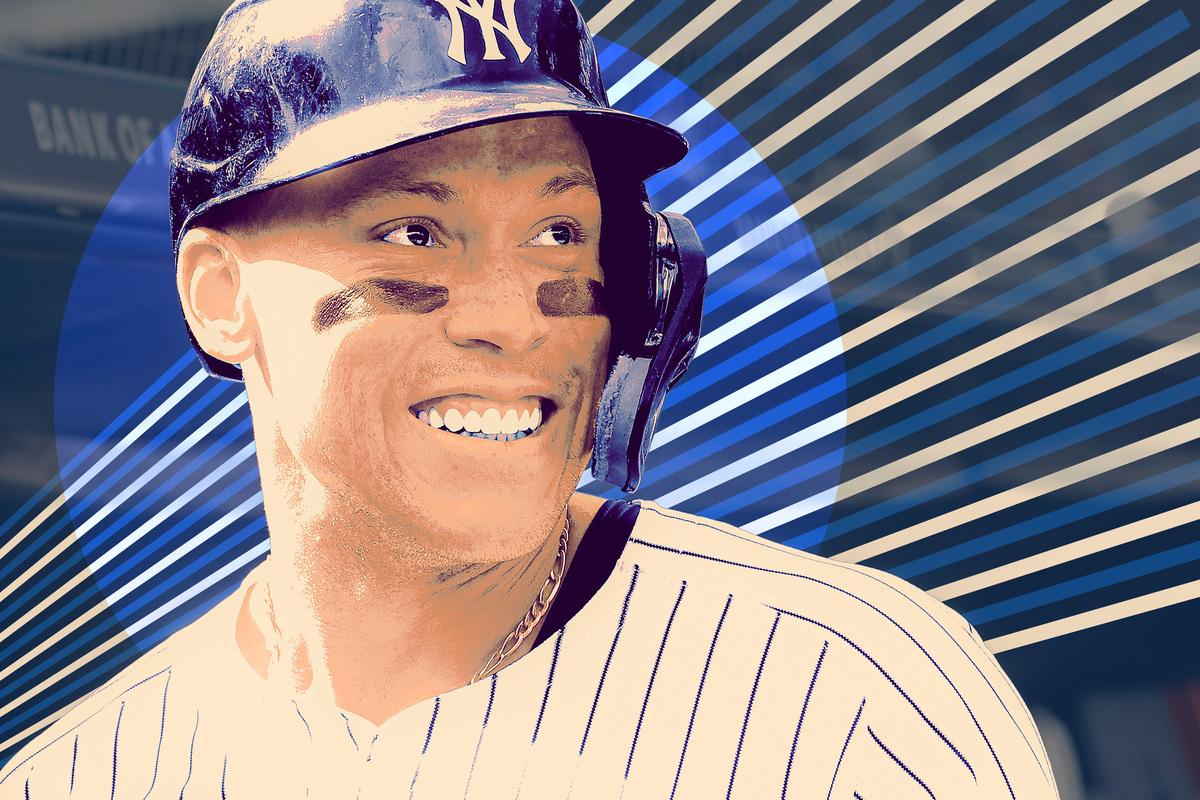
There’s an old adage, by way of Compton, that on certain occasions you’ve gotta pop out and show people. In baseball, October is one of those times. For six months, ball games are routine propositions, and then, with the change of the foliage, the stakes get tightrope high. That this is the nature of the postseason, the frantic inflection point when the marathon becomes the sprint, is both crucial and contradictory. Baseball’s divine mathematics are apparent and enduring—up until the moment they’re invariably subject to change.
Across the web of odysseys that make up the game’s century-spanning history, few have approached the grandeur of Aaron Judge’s 2024 campaign. Often, on humid weeknights and lazy afternoons, I made the pilgrimage across the East River to see the Yankee captain wield a hunk of maple in a contest beyond place or time. Three, four, and often five at-bats a game, he’d prowl the plate, hunting his own shadow, chasing after sweet-swinging ghosts. He couldn’t find what he wanted, at least not yet. Nine years into his reign, no. 99 knows the deal and the fine print.
Ballpark epics may be voiced over the summer, but they’re hewn in stone in early fall.
A dust-trailed blip soaring through the constellations of our once-national pastime, Judge carries the shape of a folk hero, and he’s long since aced the labors required to back it. He’s the best hitter since the country was so in thrall to the long ball that they looked aside the literal bloat of the figures breaking every holy artifact in the game’s history. The unspoken hang-up is that his timing is rough—not on the field, but certainly off it. Baseball isn’t dead, but it is aging, and it is regional. The postseason is the only platform capable of boosting the profile of the game’s under-promoted titans, and precious few tickets to the dance get printed. Add that Judge’s peak coincides with the most novel, all-around talented superstar in the game’s history, and you’ve got a decent, if unsatisfying, explanation for the dissonance between Judge’s shadow in the sport and outside it.
Now’s his opening. If Judge’s season wasn’t the most compelling offensive explosion in the history of the sport, it was at least the one with the fewest number of holes in its narrative. In 704 plate appearances, Judge led MLB in nearly every major offensive statistical category: He was first in home runs (58), third in batting average (.322), first in OBP (.458), and first in slugging (.701). His mind-melting OPS of 1.159 was not only 123 points higher than that of second-place finisher and Oshu bambino Shohei Ohtani—it was a full 48 points higher than when Judge broke the AL HR record in 2022. His home run total was tied for the 12th-highest single-season outburst in the history of the game. He was one of just 14 men to ever slug above .700 with a minimum of 550 plate appearances.
If advanced stats are your groove, Judge has those in bunches: Baseball Reference has his WAR at 10.8, while FanGraphs puts it at an even more bullish estimation of 11.2—21st and 19th highest since 1900, respectively. The gap between Judge’s 223 park-adjusted OPS+ (wherein 100 is a league average hitter) and Ohtani’s, in second place, is greater than the difference between Ohtani’s and the eighth-place finisher’s. Judge’s weighted runs created likewise lap the field by 38 points, more than the difference between second, again Ohtani, and no. 11, Phillies first baseman Bryce Harper. When using FanGraphs’ total “offense” measurement—which accounts for productivity at the plate and on the bases—Judge’s 2024 is the 12th best in the history of baseball. (Ohtani’s is 38th best.)
Judge is playing at a time of apex velocity, spin, strength, and speed. Ballplayers are as fit as they have ever been, sports science has moved leaps and bounds, and cigars are no longer tolerated mid-game. His competition isn’t limited by color, nationality, or even physical phenotype, and, crucially, he’s putting up all of these numbers without the aid of performance enhancers. There are other rarities worthy of focus this year in the sport, but the thing about rarity in occurrence is that it doesn’t always equate to rarity in impact. All year Judge has been the most valuable player, in the most valuable ways.
The highest right-handed peak in baseball history is a lesson in brutal efficiency. Going into his free agent walk year in 2022, the slugger pared down his swing. He moved his hands forward in his stance, from near the interior point of his right collarbone to the center of his sternum. He strived toward utter potency in movement, loading his hips, in his words, “like a rubber band,” and then letting them unfurl in sync with his base. The largest position player by body mass in MLB history, Judge is a literal wrench in the power scale.
His body breaks the margins of the game and is as immaculately maintained as any on a baseball field. To combat a bout of injury concerns in his early pro years, Judge formulated a regimen of near-constant care and recovery. He swears by cold plunges, sauna work, intermittent fasting, and regular total body workouts, most often directly before and after games. What—if anything—he sacrificed over recent years in power, he gained in strike zone restraint. The more disadvantageous the count, the more still he becomes.
When Judge started 2024 with a monthlong slump, he doubled down on these same principles. One day he decided to close his batting stance off, moving his left foot closer to the plate and standing slightly more erect. “A lot of teams, they love to throw slider away, slider away, and then show heaters inside and then slider away,” he told reporters of the shift. Starting his swing “a little closed or a little more straight up” helped him “stay on those [pitches] a little better.” More than once, even at a distance of a hundred or so feet away along the third baseline, I have seen Judge eye down a buckling sweeper, just before it falls off the outside corner, or refuse to chase a high-90s fastball tailing toward his ribs. It’s not that he isn’t occasionally beaten on a pitch, or two, or even three: It’s that when he is beaten, it almost always happens on his terms. To watch a Judge at-bat today is to see the strongest slugger in the game’s history manage to be, simultaneously, less reliant on and more trusting of that strength than he has ever been before.
When someone like Judge’s teammate, the 6-foot-6-inch Giancarlo Stanton, fully squares a ball up, he channels a level of force that is, at its essence, uncontrollable. The variance, swing to swing, is a product of that polarizing force: He often whiffs, sometimes hideously. (He also sometimes does this.) Contact gods like the San Diego Padres’ Luis Arraez function almost oppositely in the batter’s box. They brandish so much control so thoroughly that there are only so many places the ball can end up—their opponents know this—and still it doesn’t matter; they find the hole. This year, Judge has managed to merge these two styles to a degree unseen outside the reigns of Ruth, Williams, and Bonds. He has the control to guide the ball where he wants and the power to get it anywhere. Sharing the lineup with the likewise preternatural Juan Soto has provided Judge with a level of on-base leverage unseen at any point in his career, a reality the slugger has often taken ruthless advantage of.
That someone with this level of mastery was hiding in plain sight for the better part of a decade remains the most astounding part of Judge’s journey. As a boy, he stuck out in nearly every way imaginable—he was a towering brown-skinned child, in a small Central Valley farming town with enough Black folks to count on your fingers—yet on the field he was content with blending in. He was never a pull hitter in high school: His own coaches attested to the fact that his power swing “was the last thing to come.” After getting drafted in the 31st round by the nearby Oakland A’s, Judge committed to his parents’ alma mater, Fresno State, where even his supporters initially described him as “a newborn giraffe” and “gangly.” Ultimately the 32nd pick in 2013, Judge climbed up the Yankees farm system as scouts eyed his high ceiling but fretted over his swing-and-miss potential. MLB Pipeline’s summary on Judge before 2017—the very year he broke the rookie record for HRs—warned, “He won’t hit for average unless he closes some holes in his swing.”
In the years since Judge first broke onto the scene, he’s set a new AL single-season home run record, reached 300 homers faster than anyone in history, and maintained a career OPS of 1.010. He is now virtually guaranteed to take home his second MVP award. Even accounting for his limited, out-of-position defense this year, Judge has been worth at least two wins more on offense than the next-closest player, Bobby Witt Jr., over the course of the season and at least two and a half more wins than Ohtani, according to both Baseball Reference and FanGraphs. Judge’s 2024 output ranks as the seventh best at the plate in the history of the sport for park- and era-adjusted wRC+, tied with Babe Ruth’s 1921 season at 218—a full 12 points higher than his own 2022 season. Judge is one of just four men to have repeat seasons in the top 25, alongside Ted Williams (six times), Babe Ruth (eight times), and Barry Bonds (four times).
What he hasn’t done—the one thing standing between him and ultimate baseball immortality—is pop in the playoffs. Out of the eight full postseason series Judge has competed in, he’s finished with an OPS above 1.000 in just two of them. He’s never gotten closer to the World Series than during his first run, in 2017—when the Bombers fell in seven games to a trash-can-worshiping cult buzzsaw in Houston. It’s been 15 years since the Yankees last hoisted the trophy. At 32, Judge finally has a teammate in his orbit offensively in Soto, his team has home field advantage through the ALCS, and his league is as wide open as it’s been in years.
Over the marathon, he matched the unmatchable. If Judge and Soto are who they were most of their summers, the Canyon of Heroes is a likely destination. If they aren’t, the squad will eventually bomb. That’s the game. Always has been. You see something like this only so often. A few moments every century. To be the best, now’s the time to shine, and show out.

